tire pressure MERCEDES-BENZ SL ROADSTER 2019 Owner's Manual
[x] Cancel search | Manufacturer: MERCEDES-BENZ, Model Year: 2019, Model line: SL ROADSTER, Model: MERCEDES-BENZ SL ROADSTER 2019Pages: 330, PDF Size: 53.05 MB
Page 26 of 330
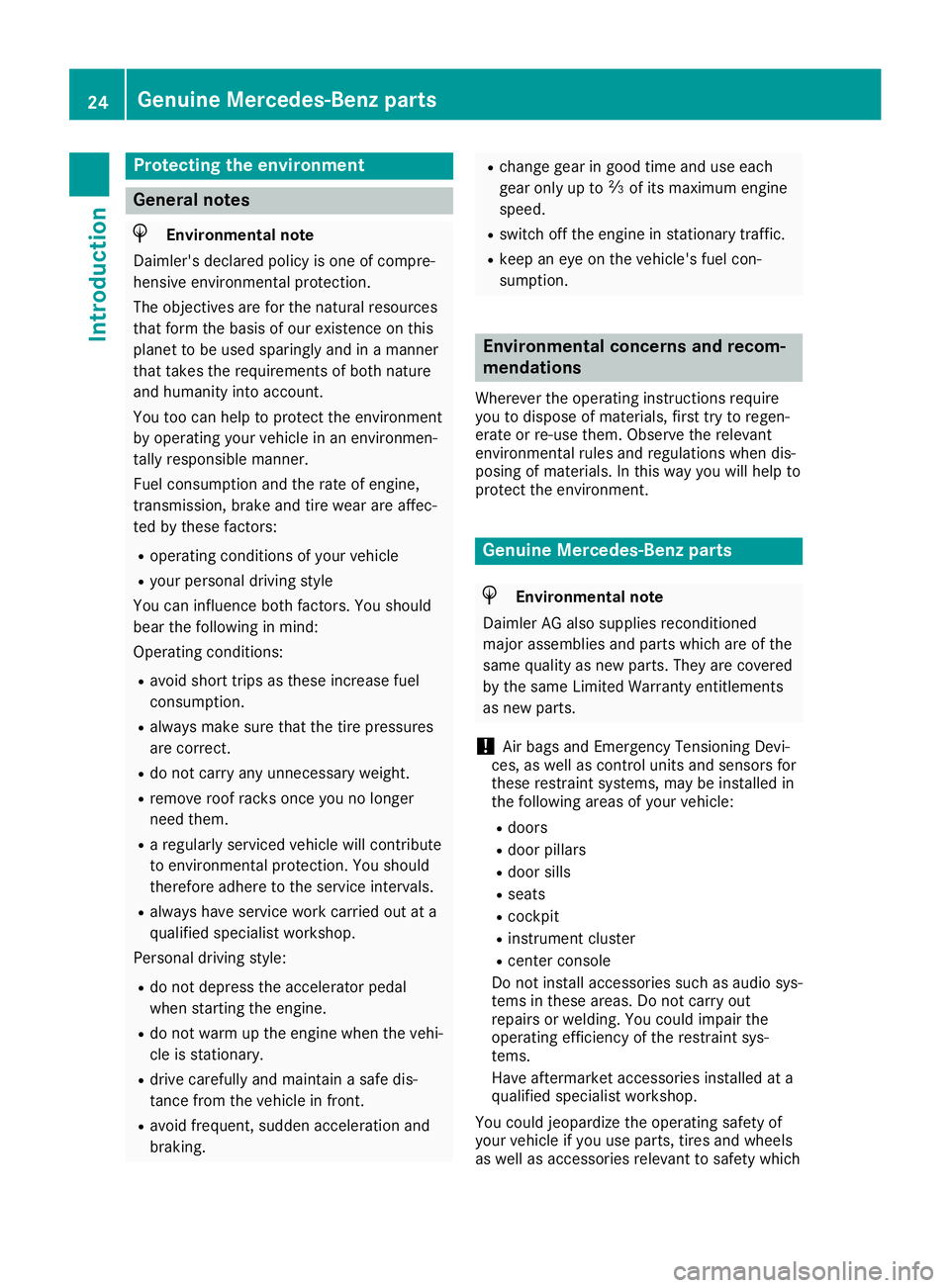
Protecting
theenvironment General
notes H
Environmental
note
Daimler's declaredpolicyisone ofcompre-
hensive environm entalprotect ion.
The object ivesareforthe natural resources
that form thebasis ofour existen ceon this
planet tobe used sparingly andinamanner
that takes therequirements ofboth nature
and humanity intoaccount.
You toocan help toprotect theenvironm ent
by operating yourvehicle inan environm en-
tally responsible manner.
Fuel consumpt ionand therate ofengine,
transm ission,brakeandtirewear areaffec-
ted bythese factors:
R operating conditionsof your vehicle
R your personal drivingstyle
You caninfluence bothfactors. Youshould
bear thefollowing inmind:
Operating conditions:
R avoid shorttripsasthese increase fuel
consumpt ion.
R alwa ysmake surethatthetire pressures
are correct .
R do not carry anyunnecessary weight.
R remove roofracks onceyounolonger
need them.
R aregularly servicedvehiclewillcont ribute
to environm entalprotect ion.You should
therefore adheretothe service intervals.
R alwa yshave service workcarried outata
quali fiedspecialist workshop.
Personal drivingstyle:
R do not depress theaccelerator pedal
when startin gthe engine.
R do not warm upthe engine whenthevehi-
cle isstationary.
R drive carefully andmaintain asafe dis-
tance fromthevehicle infront .
R avoid frequent, suddenacceleration and
braking. R
change gearingood timeanduseeach
gear onlyupto00C3 ofits maximum engine
speed.
R switch offthe engine instationary traffic.
R keep aneye onthe vehicle's fuelcon-
sumption. Environmental
concerns andrecom-
mendat ions
Wherever theoperating instructionsrequire
you todispose ofmaterials, firsttrytoregen-
erate orre-use them.Observe therelevant
environm entalrulesandregulations whendis-
posing ofmaterials. Inthis way youwillhelp to
protect theenvironm ent. Genuine
Mercedes-Benz parts H
Environmental
note
Daimler AGalso supplie srecondit ioned
major assemblies andparts which areofthe
same qualityas new parts. Theyarecovered
by the same Limited Warranty entitlements
as new parts.
! Air
bags andEmergen cyTensioning Devi-
ces, aswell ascont rolunits andsensors for
these restraint systems, maybeinstalled in
the following areasofyour vehicle:
R doors
R door pillars
R door sills
R seats
R cock pit
R instrumen tcluster
R cent erconsole
Do not install accessories suchasaudio sys-
tems inthese areas. Donot carry out
repairs orwelding. Youcould impair the
operating efficiency ofthe restraint sys-
tems.
Have aftermark etaccessories installedata
quali fiedspecialist workshop.
You could jeopardize theoperating safetyof
your vehicle ifyou useparts, tiresandwheels
as well asaccessories relevanttosafety which 24
Genuine
Mercedes-Benz partsIntrodu ction
Page 153 of 330
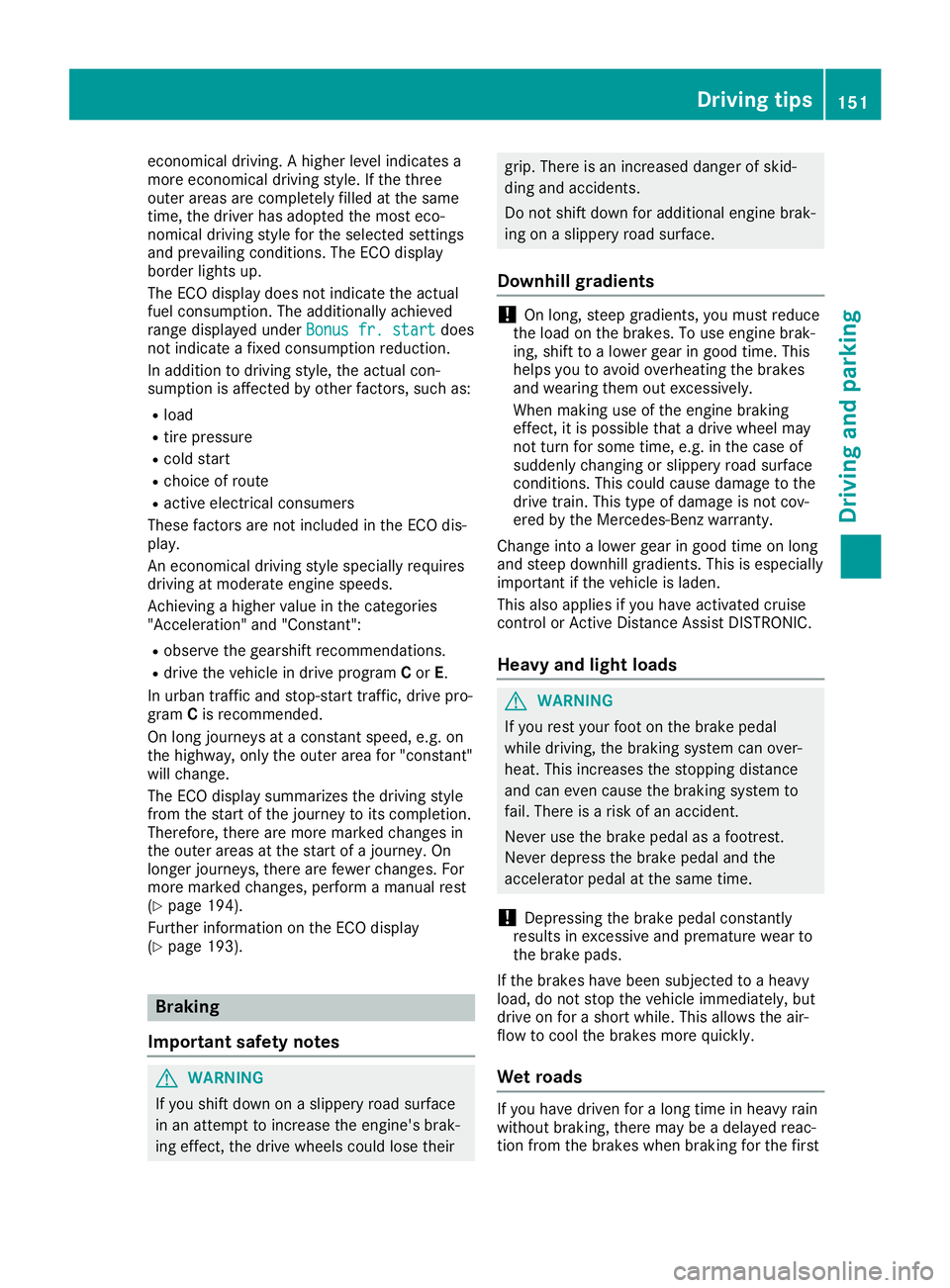
econ
omical driving. Ahigher levelindicat esa
more economical driving style.Ifthe three
outer areas arecomplet elyfilled atthe same
time, thedriver hasadopted themost eco-
nomic aldriving styleforthe select edsett ings
and prevailing conditions .The ECO display
border lightsup.
The ECO display doesnotindicat ethe actual
fuel consumption .The additionally achieved
range displayed underBonus fr.start Bonus
fr.start does
not indicat eafixed consumption reduction.
In addition todriving style,theactual con-
sumption isaffect edbyother factors, such as:
R load
R tire pressure
R cold start
R choice ofroute
R active electricalconsumers
These factorsare not included inthe ECO dis-
play.
An econ omical driving stylespecially requires
driving atmoderate enginespeeds.
Ach ieving ahigher valueinthe categor ies
"Acc eleration" and"Constan t":
R observe thegearshift recommendat ions.
R drive thevehicle indrive program Cor E.
In urban trafficand stop- start traffic,drive pro-
gram Cis recom mended.
On long journ eysatacon stant speed, e.g.on
the highway, onlytheouter areafor"const ant"
will change.
The ECO display summarizes thedriving style
from thestart ofthe journ eytoits complet ion.
Therefor e,there aremore marked changes in
the outer areas atthe start ofajourn ey.On
longer journeys,there arefewer changes .For
more marked changes ,perform amanual rest
(Y page 194).
Furt herinfor mation onthe ECO display
(Y page 193). Br
aking
Impor tantsafety notes G
WARN
ING
If you shift down onaslippery roadsurface
in an attem pttoincr ease theengine' sbrak-
ing effec t,the drive wheels couldlosetheir grip.
There isan incr eased danger ofskid-
ding andacciden ts.
Do not shift down foradditional enginebrak-
ing onaslippery roadsurface.
Downhill gradients !
On
long, steep gradient s,you must reduce
the load onthe brakes. Touse engine brak-
ing, shift toalower gearingood time. This
helps youtoavoid overheat ingthe brakes
and wearing themoutexces sively.
When making useofthe engine braking
effec t,itis possible thatadrive wheel may
not turn forsome time,e.g.inthe case of
suddenly changingor slippery roadsurface
con ditions .This could cause damage tothe
drive train.This type ofdamage isnot cov-
ered bythe Mercedes- Benzwarrant y.
Change intoalower gearingood timeonlong
and steep downhill gradients.This isespecially
import antifthe vehicle isladen.
This also applies ifyou have activat edcruise
con trol orAct ive Dist ance Assist DISTRONIC.
Heavy andlight loads G
WARN
ING
If you rest your footonthe brake pedal
while driving, thebraking systemcanover-
heat. Thisincreases thestoppin gdistanc e
and caneven cause thebraking systemto
fail. There isarisk ofan acciden t.
Never usethebrake pedalasafootr est.
Never depress thebrake pedalandthe
accelerat orpedal atthe same time.
! Depress
ingthe brake pedalconstant ly
results inexces siveandpremature wearto
the brake pads.
If the brakes havebeen subject edtoaheavy
load, donot stop thevehicle immediately, but
drive onfor ashort while. Thisallows theair-
flow tocool thebrakes morequickly.
Wet roads If
you have driven foralong time inheavy rain
without braking,there maybeadelayed reac-
tion from thebrakes whenbraking forthe first Driving
tips
151Driving andparking Z
Page 166 of 330
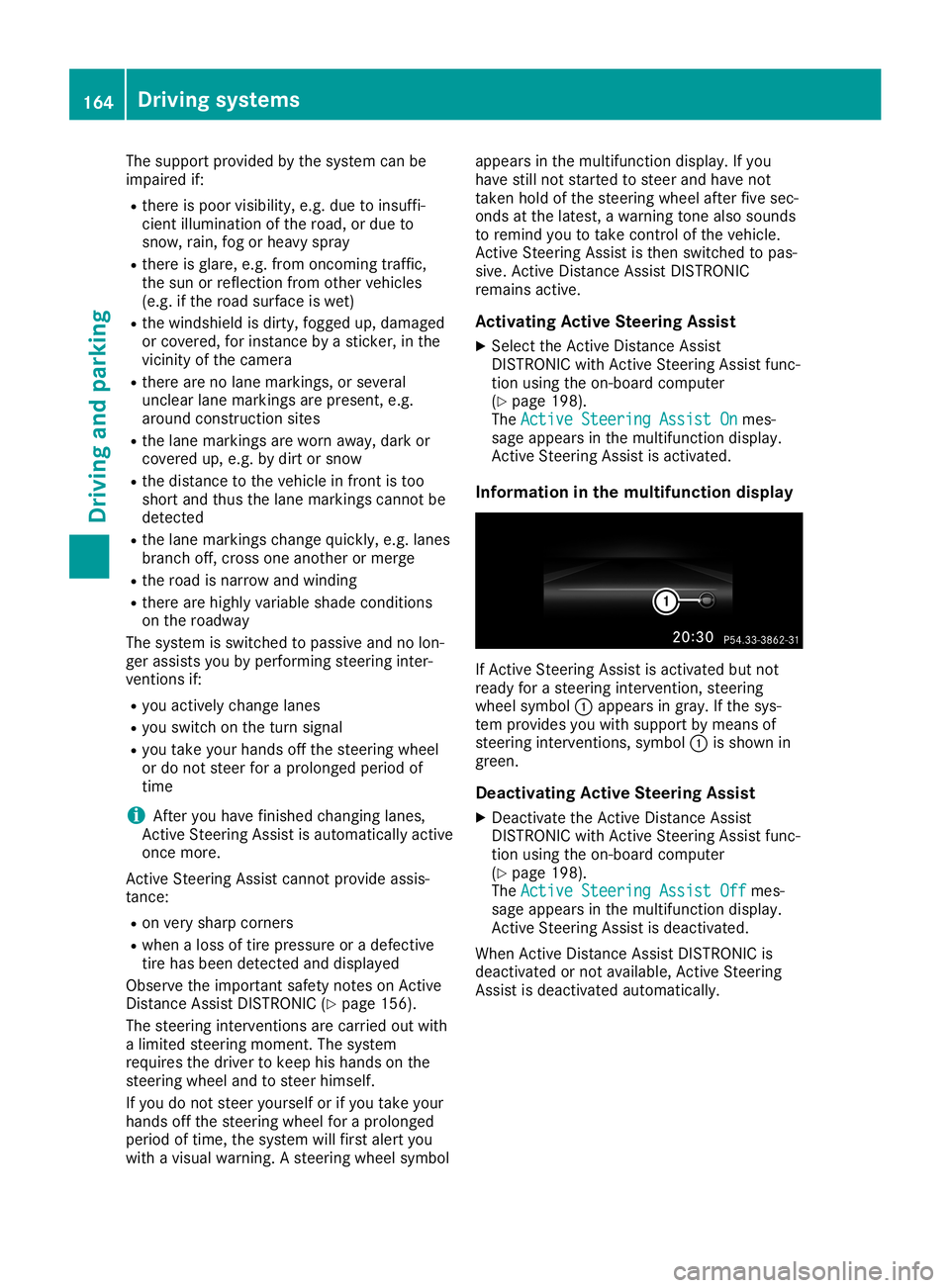
The
support provided bythe system canbe
impaired if:
R there ispoor visibility, e.g.due toinsuffi-
cient illumination ofthe road, ordue to
snow, rain,fogorheavy spray
R there isglare, e.g.from oncom ingtraff ic,
the sun orreflect ionfrom other vehicles
(e.g. ifthe road surface iswet)
R the windshield isdirty, fogged up,damaged
or covered, forinstan cebyastick er,inthe
vicinit yof the camera
R there arenolane markings ,or several
unclear lanemarkings arepresent ,e.g.
around construction sites
R the lane marking sare worn away,dark or
covered up,e.g. bydirt orsnow
R the distance tothe vehicle infront istoo
short andthus thelane markings cannotbe
detect ed
R the lane markings changequickly, e.g.lanes
branch off,cross oneanother ormerge
R the road isnarrow andwinding
R there arehighly variable shadeconditions
on the roadway
The system isswitched topassive andnolon-
ger assists youbyperformin gsteerin ginter -
vent ions if:
R you actively changelanes
R you switch onthe turn signal
R you take your hands offthe steerin gwheel
or do not steer foraprolonged periodof
time
i Aft
eryou have finished changing lanes,
Act ive Steer ingAssist isautomatically active
once more.
Act ive Steer ingAssist cannotprovide assis-
tanc e:
R on very sharp corners
R when aloss oftire pressure oradefect ive
tire has been detect edand display ed
Observe theimportant safetynoteson Act ive
Distan ceAssist DISTRONIC (Ypage 156).
The steerin ginter ventions arecarried outwith
a limited steeringmoment .The system
requires thedriver tokeep hishands onthe
steerin gwheel andtosteer himself.
If you donot steer yourself orifyou take your
hands offthe steerin gwheel foraprolonged
period oftime, thesystem willfirst alert you
with avisual warning. Asteerin gwheel symbol appears
inthe multifunct iondisplay .If you
have stillnotstart edtosteer andhave not
taken holdofthe steerin gwheel afterfivesec-
onds atthe latest, awarning tonealso sounds
to remind youtotake controlofthe vehicle.
Act ive Steer ingAssist isthen switched topas-
sive. Active Distan ceAssist DISTRONIC
remains active.
Activating ActiveSteering Assist
X Select theActive Distan ceAssist
DIS TRONIC withActive Steer ingAssist func-
tion using theon-board computer
(Y page 198).
The Active Steering AssistOn Active
Steering AssistOnmes-
sage appears inthe multifunct iondisplay .
Act ive Steer ingAssist isactivated.
Informa tioninthe mult ifunction display If
Act ive Steer ingAssist isactivated butnot
ready forasteerin ginter vention,steerin g
wheel symbol 0043appears ingray. Ifthe sys-
tem provides youwith support bymeans of
steerin ginter ventions, symbol 0043isshown in
green.
Deactivating ActiveSteering Assist
X Deact ivatetheActive Distan ceAssist
DIS TRONIC withActive Steer ingAssist func-
tion using theon-board computer
(Y page 198).
The Active Steering AssistOff Active
Steering AssistOffmes-
sage appears inthe multifunct iondisplay .
Act ive Steer ingAssist isdeactivated.
When Active Distan ceAssist DISTRONIC is
deactivated ornot availabl e,Act ive Steer ing
Assist isdeactivated automatically.164
Driving
systemsDriving andparking
Page 178 of 330
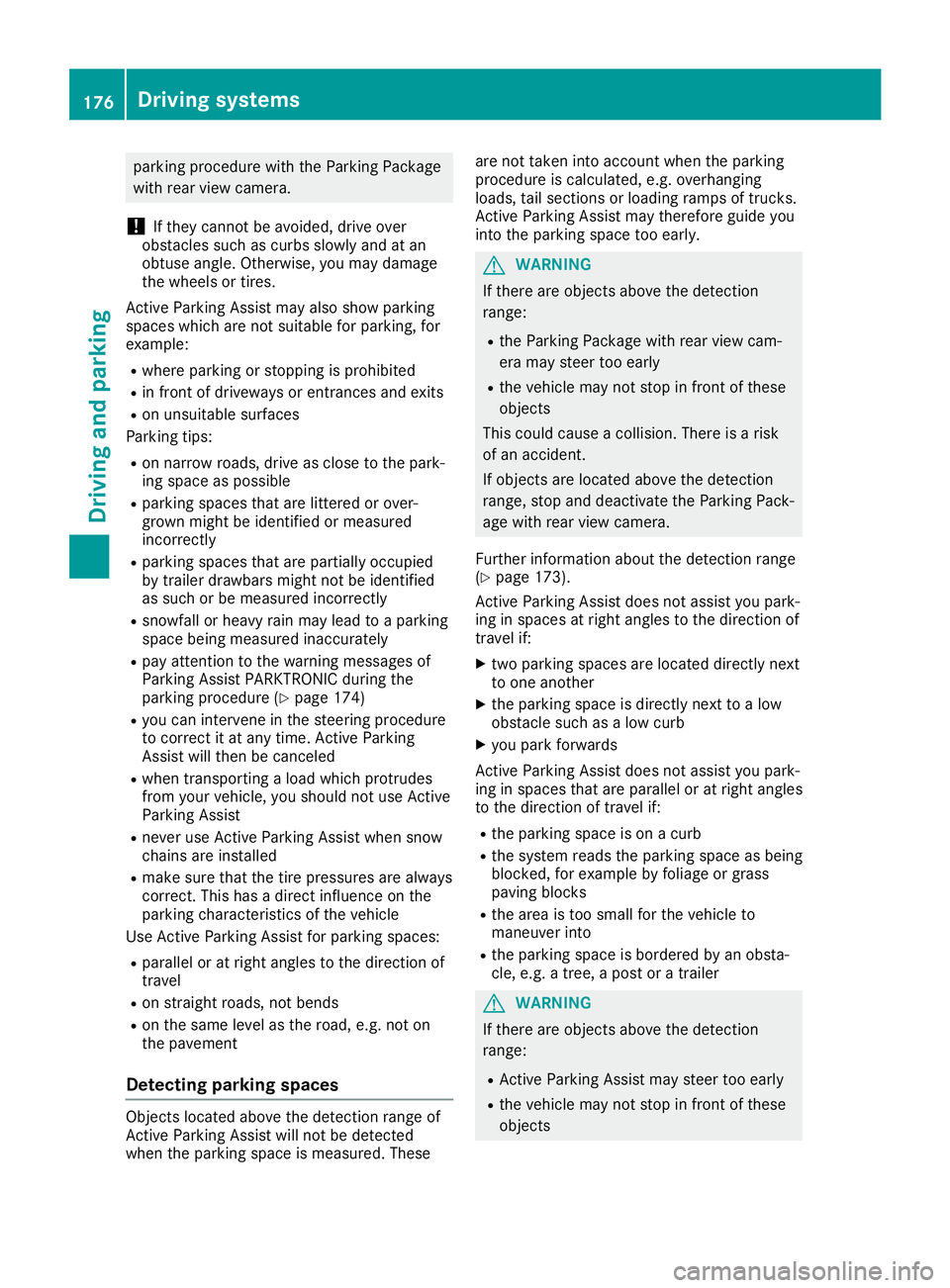
parkin
gprocedure withtheParkin gPackage
with rearview camera.
! If
they cannotbe avoided, driveover
obstac lessuch ascurbs slowly andatan
obtuse angle.Otherwise, youmay damage
the wheels ortires.
Ac tive Parkin gAssist mayalsoshow parkin g
spaces whicharenot suitable forparkin g,for
example:
R where parkingor stoppin gis prohibited
R in fron tof driveways orent ranc esand exits
R on unsuitable surfaces
Parkin gtips:
R on narro wroads, driveasclose tothe park-
ing space aspossible
R parkin gspaces thatarelittered orover-
grown mightbeident ifiedormeasured
incor rectly
R parkin gspaces thatarepartially occupied
by trailer drawbars mightnotbeident ified
as such orbe measured incorrectly
R snowfall orheavy rainmay lead toaparkin g
space beingmeasured inaccurately
R pay attention tothe warning messages of
Parkin gAssist PARKTRONI Cduring the
parkin gprocedure (Ypage 174)
R you can interven ein the steer ingprocedure
to corr ectitat any time. Active Parkin g
Assist willthen becanc eled
R when transport ingaload which protrudes
from yourvehicle, youshould notuse Active
Parkin gAssist
R never useActive Parkin gAssist whensnow
chains areinstalled
R make surethatthetire pressures arealways
corr ect.This hasadirect influen ceon the
parkin gcharact eristicsof the vehicle
Use Active Parkin gAssist forparkin gspaces:
R parallel oratright angles tothe direct ionof
trav el
R on straight roads, notbends
R on the same levelasthe road, e.g.noton
the pavement
Detecting parking spaces Objec
tslocated abovethedetec tionrange of
Ac tive Parkin gAssist willnotbedetec ted
when theparkin gspace ismeasured. These are
not taken intoaccoun twhen theparkin g
procedure iscalculated, e.g.overhan ging
loads, tailsect ions orloading rampsoftruc ks.
Ac tive Parkin gAssist maytherefore guide you
int othe parkin gspace tooearly. G
WARN
ING
If ther eare objec tsabove thedetec tion
range:
R the Parkin gPackage withrearview cam-
era may steer tooearly
R the vehicle maynotstop infron tof these
objec ts
This could cause acollision. Thereisarisk
of an acciden t.
If objec tsare located abovethedetec tion
range, stopanddeactiv atethe Parkin gPack-
age with rearview camera.
Furt herinfor mation aboutthedetec tionrange
(Y page 173).
Ac tive Parkin gAssist doesnotassist youpark-
ing inspaces atright angles tothe direct ionof
trav elif:
X two parkin gspaces arelocated directlynex t
to one anot her
X the parkin gspace isdirect lynex tto alow
obstac lesuch asalow curb
X you park forwards
Ac tive Parkin gAssist doesnotassist youpark-
ing inspaces thatareparallel oratright angles
to the direct ionoftrave lif:
R the parkin gspace ison acurb
R the system readstheparkin gspace asbeing
block ed,forexample byfoliage orgrass
paving blocks
R the area istoo small forthe vehicle to
maneuver into
R the parkin gspace isbordered byan obsta-
cle, e.g. atree, apost oratrailer G
WARN
ING
If ther eare objec tsabove thedetec tion
range:
R Ac tive Parkin gAssist maysteer tooearly
R the vehicle maynotstop infron tof these
objec ts 176
Driving
systemsDriving andparking
Page 298 of 330

To
avoid hazardous situations:
R never install snowchains tothe front
wheels
R alway sinstall snowchains inpairs tothe
rear wheels.
For safety reasons, Mercedes- Benzrecom-
mends thatyouonly usesnow chains that
have been specially approved foryour vehicle
by Mercedes- Benz,or are ofacorrespon ding
standard ofquality. Formore inform ation,
please contactaqualified specialist workshop.
If you inten dto mount snowchains, please
bear thefollowing pointsinmind:
R Snow chains maynotbemounted onall
wheel/tire combinations.Permissible
wheel-tire combinations(Ypage 318).
R Only usesnow chains whendriving onroads
completely coveredbysnow. Remove the
snow chains assoon aspossible whenyou
come toaroad thatisnot snow-c overed.
R Local regulations mayrestrictthe use of
snow chains. Observe theappropriate regu-
lations ifyou wish tomount snowchains.
R Do not exceed themaximum permissible
speed of30 mph (50km/ h).
R On vehicles withActive Body Control (ABC),
if snow chains havebeen installed, youmust
drive ataraised vehicle level(Ypage 168).
You may wish todeactivate ESP®
when pulling
away withsnow chains installed (Ypage 66).
You canthereby allowthewheels tospin ina
cont rolled manner ,achieving anincreased
driving force(cuttingaction). Tire
pressur e Tire
pressur especifications
Import antsafety notes G
WARNIN
G
Underinf latedoroverinflat edtires pose the
following risks:
R the tires mayburst, especially asthe load
and vehicle speedincrease.
R the tires maywear excessiv elyand/or
unevenly, whichmaygreatly impairtire
tract ion.
R the driving charact eristics, aswell as
steerin gand braking, maybegreatly
impaired.
There isarisk ofan accident .
Follow recomm endedtireinflation pressures
and check thepressure ofall the tires
including thespare wheel:
R mont hly,atleast
R ifthe load changes
R before beginning along journey
R under different operating conditions,e.g.
off- road driving
If necessary, correctthe tire pressure.
The data onthe Tire andLoading Information
placard andtirepressure tableshown hereare
examples. Tirepressure specification sare
vehicle-spec ificand may deviate fromthedata
shown here.Thetirepressure specification s
that arevalid foryour vehicle canbefound on
the Tire andLoading Information placard and
tire pressure tableonthe vehicle.
General notes The
recomm endedtirepressures forthe tires
mounted atthe factor ycan befound onthe
labels described here.
Further informationontire pressures canbe
obtained ataqualified specialist workshop. 296
Tir
epr essureWheels andtires
Page 301 of 330
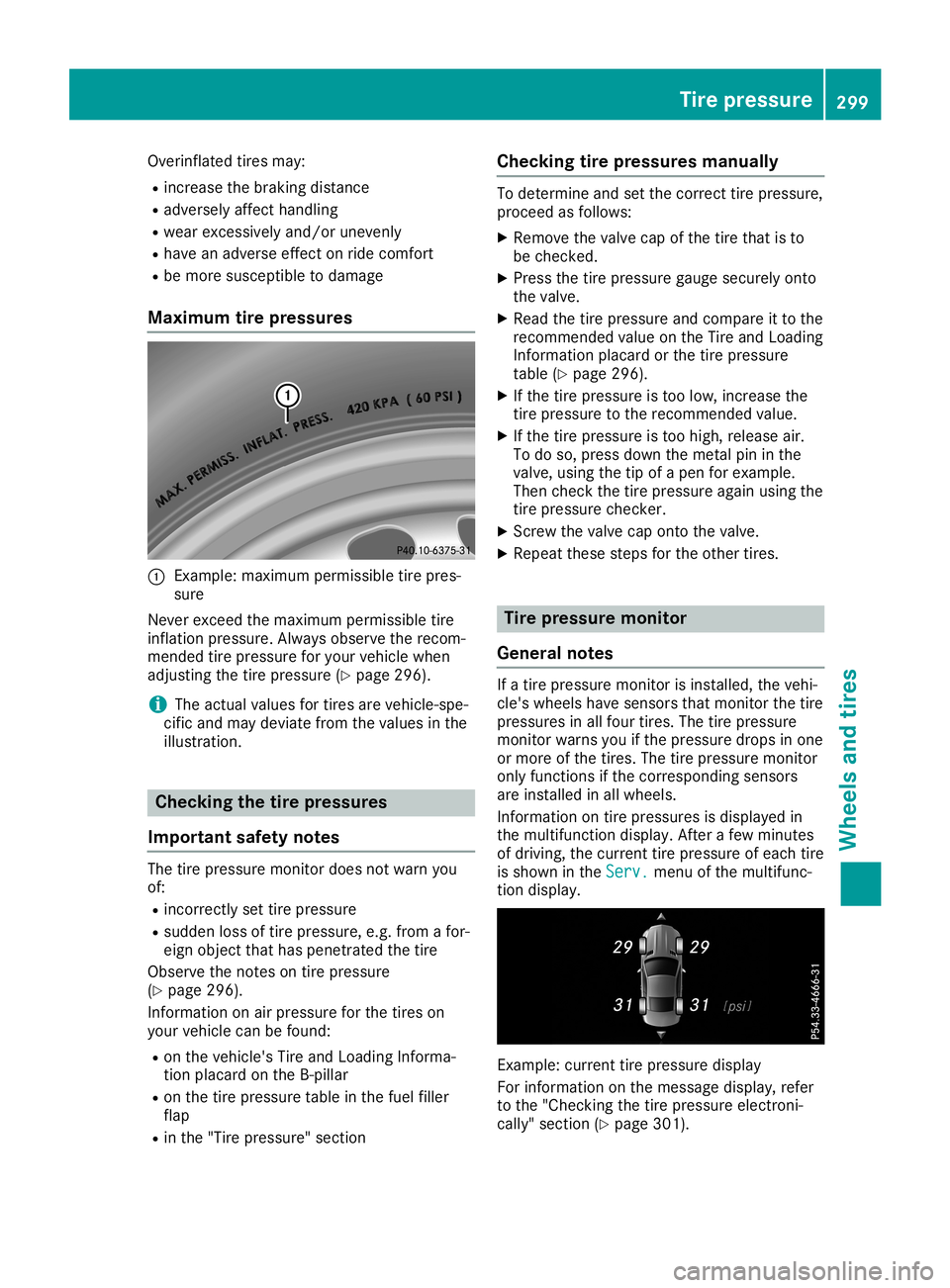
Overinflated
tiresmay:
R increase thebraking distance
R adversely affecthandling
R wear excessively and/orunevenly
R have anadverse effectonride comfort
R be more susceptible todamage
Maximum tirepressures 0043
Example: maximum permissibletire pres-
sure
Never exceed themaximum permissibletire
inflation pressure. Alwaysobserve therecom-
mended tirepressure foryour vehicle when
adjusting thetire pressure (Ypage 296).
i The
actual valuesfor tires arevehicle-spe-
cific andmay deviate fromthevalue sin the
illu stration. Checki
ngthe tire pressures
Importa ntsafety notes The
tirepressure monitordoesnotwarn you
of:
R incorrect lyset tire pressure
R sudden lossoftire pressure, e.g.from afor-
eign object thathaspenetrated thetire
Observe thenotes ontire pressure
(Y page 296).
Information onair pressure forthe tires on
your vehicle canbefound:
R on the vehicle's TireandLoading Informa-
tion placard onthe B-pillar
R on the tire pressure tableinthe fuel filler
flap
R in the "Tire pressure" section Checki
ngtire pressures manually To
determine andsetthe correct tirepressure,
proceed asfollows:
X Remove thevalve capofthe tire that isto
be checked.
X Press thetire pressure gaugesecurely onto
the valve.
X Read thetire pressure andcompare itto the
recommended valueonthe Tire andLoading
Information placardorthe tire pressure
table (Ypage 296).
X Ifthe tire pressure istoo low, increase the
tire pressure tothe recommended value.
X Ifthe tire pressure istoo high, release air.
To do so, press downthemetal pininthe
valve, usingthetipofapen forexample.
Then check thetire pressure againusing the
tire pressure checker.
X Screw thevalve caponto thevalve.
X Repea tthese stepsforthe other tires. Tire
pressure monitor
General notes If
atire pressure monitorisinstalled, thevehi-
cle's wheels havesensors thatmonitor thetire
pressures inall four tires. Thetirepressure
monitor warnsyouifthe pressure dropsinone
or more ofthe tires. Thetirepressure monitor
only functions ifthe corresponding sensors
are installed inall wheels.
Information ontire pressures isdispla yedin
the multifunction display.After afew minutes
of driving, thecurrent tirepressure ofeach tire
is shown inthe Serv. Serv.
menuofthe multifunc-
tion displa y. Example:
currenttirepressure display
For information onthe message display,refer
to the "Checking thetire pressure electroni-
cally "section (Ypage 301). Tire
pressur e
299Wheels andtires Z
Page 303 of 330

stantly,
thetire pressure monitorismalfunc-
tioning.
In addition tothe warning lamp,amessage
appea rsinthe multifunction display.Observe
the information ondispla ymessages
(Y page 227).
It may take uptoten minutes foramalfunc-
tion ofthe tire pressure monitortobe indica-
ted. Amalfunction willbeindicated bythe tire
pressure warninglampflashing forapprox-
imately oneminute andthen remaining lit.
When themalfunction hasbeen rectified, the
tire pressure warninglampgoesoutafter a
few minutes ofdriving.
The tirepressure valuesindicated bythe on-
board computer maydiffer fromthose meas-
ured atagas station withapressure gage.The
tire pressures shownbythe on-board com-
puter refertothose measured atsea level. At
high altitudes, thetire pressure valuesindica-
ted byapressure gagearehigher thanthose
shown bythe on-board computer. Inthis case,
do not reduce thetire pressures.
The operation ofthe tire pressure monitorcan
be affected byinterferen cefrom radio trans-
mitting equipment (e.g.radio headphones,
two-way radios)thatmay bebeing operated in
or near thevehicle.
Checki ngthe tire pressure electroni-
cally X
Make surethattheSmartKey isin position
0048 (Ypage 126)inthe ignition lock.
X Press the0059 or0065 button onthe steer-
ing wheel toselect theServ. Serv.
menu.
X Press the0063 or0064 button toselect
Tire Pressure Tire
Pressure.
X Press 0076.
The current tirepressure ofeach tireis
shown inthe multifunction display.
If the vehicle hasbeen parked forover
20 minutes, theTire pressure willbe Tire
pressure willbe
displayed afterdriving afew minutes displayed
afterdriving afew minutes
message appears.
Aft erateach-in process, thetire pressure
monitor automatically detectsnewwheels or
new sensors. Aslong asaclear allocation of
the tire pressure valuetothe individua lwheels
is not possible ,the Tire Pressure Monitor Tire
Pressure Monitor
Active Active
displaymessage isshown instead of
the tire pressure display.The tirepressures
are alread ybeing monitored. Tire
pressure monitorwarning mes-
sages The
tirepressure monitordetectsapressure
loss inone ormore tires:
R Ifthe tire pressure monitordetectsapres-
sure lossinone ormore tires,awarning
message isshown inthe multifunction dis-
play .The yellow tire pressure warninglamp
then lights up.
R Ifthe Please Correct TirePressure Please
Correct TirePressure
message appearsinthe multifunction dis-
play ,the tire pressure inat least onetireis
too low. Thetirepressure mustbecorrect ed
when theopportunity arises.
R Ifthe Check Tires Check
Tiresmessage appearsinthe
multifunction display,the tire pressure inat
least onetirehas dropped significantly. The
tires must bechecked.
R Ifthe Warning TireMalfunction Warning
TireMalfunction mes-
sage appea rsinthe multifunction display,
the tire pressure inat least onetirehas
dropped suddenly .The tires must be
checked.
Observe theinstruct ionsandsafety notesin
the displa ymessages inthe "Tires" section
(Y page 227).
If the wheel positions onthe vehicle arerota-
ted, thetire pressures maybedispla yedfor
the wrong positions forashort time.Thisis
rectified afterafew minutes ofdriving, andthe
tire pressures aredispla yedforthe correct
positions.
Restart ingthe tire pressure monitor When
yourestart thetire pressure monitor,all
existing warning messages aredeleted andthe
warning lampsgoout. Themonitor usesthe
currently settire pressures asthe reference
values formonitoring. Inmost cases, thetire
pressure monitorwillautomaticall ydetect the
new reference valuesafteryouhave changed
the tire pressure. However, youcan also set
reference valuesmanuall yas described here.
The tirepressure monitorthenmonitors the
new tirepressure values.
X Set thetire pressure tothe value recom-
mended forthe corresponding drivingsitua-
tion onthe Tire andLoading Information
placard onthe driver's sideB-pillar
(Y page 296). Tire
pressur e
301Wheels andtires Z
Page 305 of 330

Count
ry Ra
dio type approval number lice
nce. L'ex ploit ationest
auth oriseeaux deux condition s
suivan tes.(1) L'app areilnedoit
pas prod uiredebrouil lage,et
(2) L'aut isatuer del'appar eil
doit acceptertout brouil lage
radioe lectrique subi,memesi le
brouil lageestsusc eptible d'en
com prom ettrelefon ction ne-
men t.WARN ING:Chang esor
modi ficatio nsnot expressly
appro vedbythepart yres pon si-
ble forcom plian cecould void
th euser' sauth orityto oper ate
th eequipm ent.The term"IC: "
befo retheradio certificat ion
num beronlysign ifies Canada
tec hnical spec ificatio nswere
met . Canada IC:
2546A-MW2 433A
IC: 2546A-GG4 Thisdevic ecom -
plies withpart15oftheFCC
rules andwith licenseexe mpt
RSS standar dsofIndust ryCan-
ada. Oper ationis subj ecttothe
follo wing condition s.(1) This
devic emay notcause harmful
int erf eren ce,and (2)This devic e
must accept any interf eren ce
rec eived ,inc ludin gint erf eren ce
th at may cause undesiredoper -
atio n.Le pres entappare ilest
con forme d'indust rieCanada
applic ablesauxappare ilsradio
exe mpt sde lice nce. L'ex ploit a-
tio nest auth oriseeaux deux
con dition ssuivan tes.(1) L'ap-
pareil nedoit pasprod uirede
brouil lage,et(2) L'aut isatuer de
l'appar eildoit acceptertout
brouil lageradioe lectrique subi,
mem esi le brouil lageestsus-
cep tibled'en comprom ettrele
fon ction nem ent.WARN ING:
Chang esormodi ficatio nsnot
exp ressly appro vedbythepart y
res pon sible forcom plian ce
could voidtheuser' sauth ority
to oper atetheequipm ent.The
ter m"IC: "befo retheradio cer-
tif icat ion num beronlysign ifies
Canada technical spec ificatio ns
were met. Count
ry Ra
dio type approval number IC:
2546A-MC34 MA4 Load
ingthevehicle Inst
ruction labels fortires and loads G
WAR
NING
Ove rloade dtir es can over heat ,causi nga
blowout .Ove rloade dtir es can also impair
th est eerin gand drivingchar acteris ticsand
lead tobrak efailur e.Ther eis arisk ofacc i-
den t.
Obse rvetheload rating ofthetir es. The load
rat ing must beatleast halfoftheGAWR of
your vehicle.Nev erover load thetir es by
exc eedin gth emax imum load.
Two instruct ion labels onyour vehicle show
th emax imum possibleload.
(1) TheTire andLoadin gIn for mat ionplacar d
is on theB- pillar onthedriv er'sside. The
Tire andLoadin gIn for mat ionplacar d
shows themax imum permissiblenum ber
of occ upant sand themax imum permissi-
ble vehicle load. Italso contain sdet ails of
th etir esiz es and correspon ding pressures
for tires moun tedatthefac tory.
(2) Thevehicle iden tificat ion plat eis on the
B- pillar onthedriv er'sside. Thevehicle
iden tificat ion plat einf orm syou ofthe
gro ssveh icle weight rating .It is made up
of theveh icle weight ,all veh icle occu-
pant s,thefuel andthecar go. You canalso
fin dinf orm ationabout themax imum gross
axle weight rating onthefro ntand rear
axle.
The maximum grossaxle weight rating is
th emax imum weight that can becar ried
by one axle (front orrear axle) .Nev er
exc eed themax imum loadorthemax i-
mum grossaxle weight rating forthefro nt
or rear axle. Load
ingthevehicle
303Wheels andtires Z
Page 309 of 330
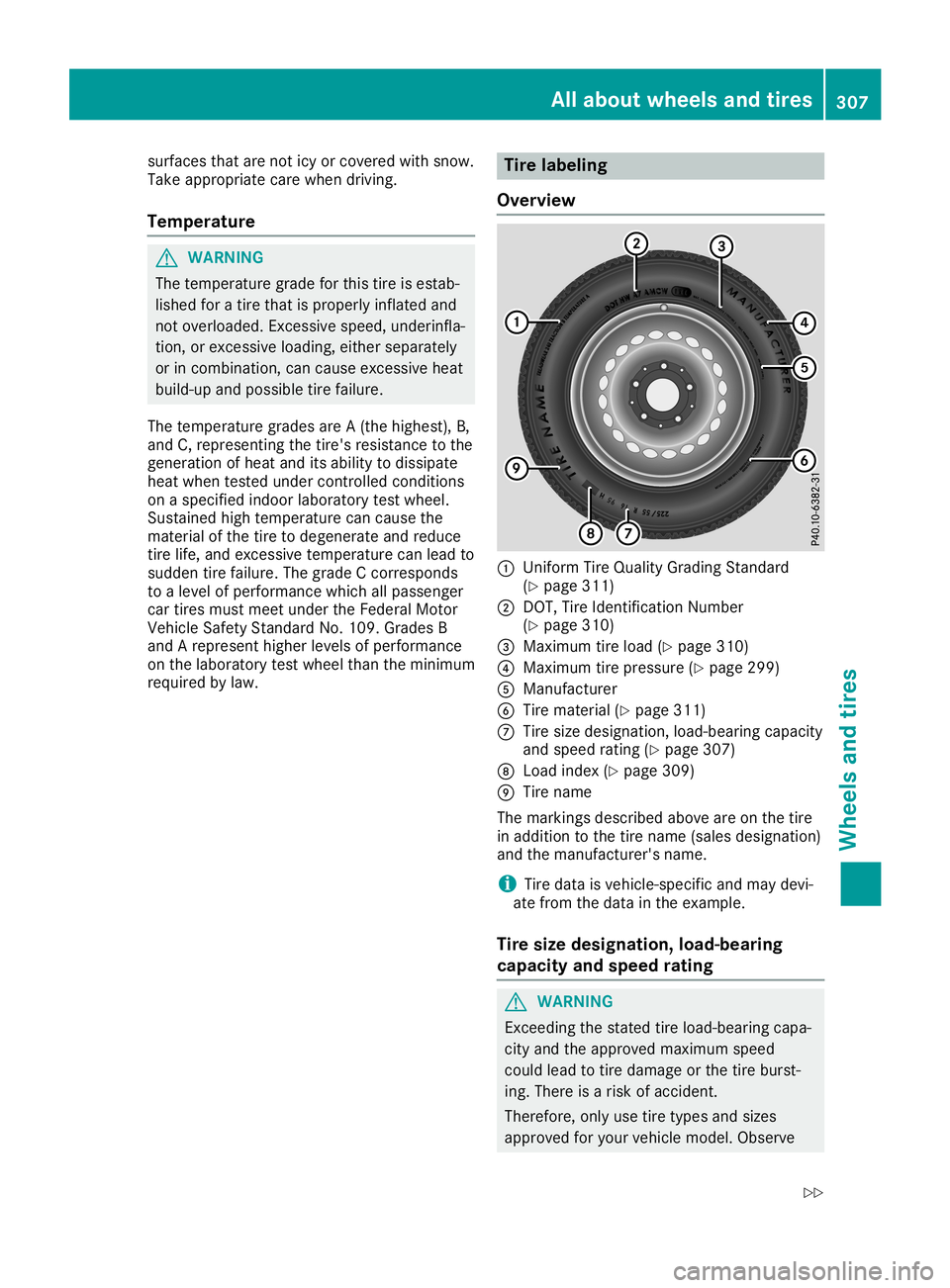
surfaces
thatarenot icyorcovered withsnow.
Take appropria tecare when driving.
Temper ature G
WARNING
The temperature gradeforthis tireisestab-
lished foratire that isproperly inflatedand
not overloaded .Exc essive speed, underinfla-
tion, orexcessive loading,either separately
or incombination, cancause excessive heat
buil d-up andpossible tirefailu re.
The temperature gradesareA(the highest), B,
and C,representing thetire's resistance tothe
generation ofheat anditsabil itytodissipa te
heat when tested undercontrolled conditions
on aspecified indoorlaboratorytestwheel.
Sustained hightemperature cancause the
material ofthe tire todegenerate andreduce
tire life, and excessive temperature canlead to
sudden tirefailu re.The grade Ccorresponds
to alevel ofperformance whichallpassenger
car tires must meet under theFederal Motor
Vehicle SafetyStandard No.109. Grades B
and Arepresent higherlevelsofperformance
on the labora torytestwheel thantheminimum
required bylaw. Tire
labeli ng
Overview 0043
Uniform TireQuali tyGradi ngStandard
(Y page 311)
0044 DOT, TireIdentification Number
(Y page 310)
0087 Maximum tireload (Ypage 310)
0085 Maximum tirepressure (Ypage 299)
0083 Manufacturer
0084 Tire material (Ypage 311)
006B Tire size designation, load-bearingcapacity
and speed rating(Ypage 307)
006C Load index (Ypage 309)
006D Tire name
The markings described aboveareonthe tire
in addition tothe tire name (sales designation)
and themanufacturer's name.
i Tire
data isvehicle-specific andmay devi-
ate from thedata inthe example.
Tire size designation, load-bearing
capacity andspeed rating G
WARNING
Exc eeding thestated tireload-bea ringcapa-
city and theapproved maximum speed
could leadtotire damage orthe tire burst-
ing. There isarisk ofaccident.
Therefore, onlyusetiretypes andsizes
approved foryour vehicle model.Observe All
about wheelsand tires
307Wheels andtires
Z
Page 312 of 330
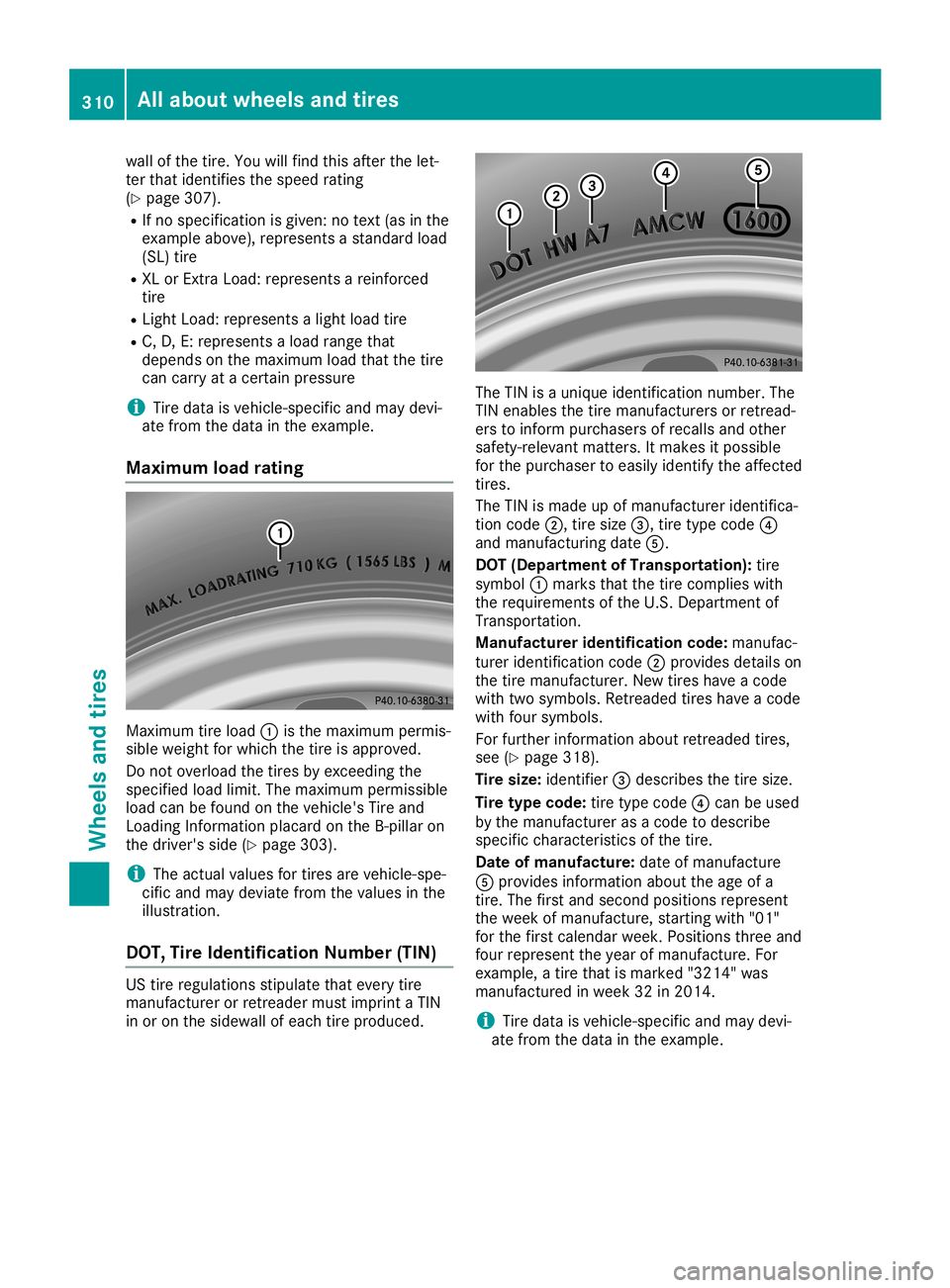
wall
ofthetir e. You willfindth is aft erthelet-
ter that iden tifies thespeed rating
(Y page 307).
R Ifno spec ification isgiven :no text(as inthe
exam pleabove) ,repr esen tsast andar dload
(SL )tir e
R XL orExtra Load: represen tsarein forced
tir e
R Light Load: represen tsalight loadtire
R C, D, E:repr esen tsaload rangethat
depen dson themax imum loadthat thetir e
can carryat acer tain pressure
i Tire
data isvehic le-speci ficand may devi-
ate fromthedata intheexam ple.
Max imumload rating Maxim
umtireload 0043isthemax imum permis-
sible weight forwhich thetir eis approv ed.
Do not over load thetir es by exc eedin gth e
spec ified loadlimit.The maximum permissible
load canbefoun don thevehic le'sTire and
Loadin gIn for mat ionplacar don theB- pillar on
th edriv er's side (Ypage 303).
i The
actual values fortires are vehic le-spe-
cif icand may deviat efro mthevalues inthe
illust ration.
DOT, TireIdent ificationNumber (TIN) US
tireregulat ionsstipulate that ever ytir e
man ufact urerorret reader mustimprintaTIN
in or on thesidewall ofeach tireproduc ed. The
TINisaunique identificat ion num ber. The
TIN enabl esthetir eman ufact urersor ret read-
ers toinform purchaser sof rec alls and other
safet y-relevan tmat ters.Itmak esitposs ible
for thepurc haser toeasily identifyth eaffe cted
tir es.
The TINismade upofman ufact ureridentifica-
tio ncod e0044, tiresiz e0087, tiretype code0085
and man ufact uringdate 0083.
DOT (Depa rtment ofTransp ortation): tire
symbo l0043 mark sth at thetir ecom plies with
th erequir ementsof theU.S .Dep artmen tof
Tran spor tation.
Man ufactu rer ident ification code: manufac-
tur eriden tificat ion code0044 prov ides details on
th etir eman ufact urer.New tires have acod e
with twosymbo ls.Retr eaded tires have acod e
with foursymbo ls.
For further inform ation about retreaded tires,
see (Ypage 318).
Tir esize: identifier 0087 desc ribes thetir esiz e.
Tir ety pe code: tiretype code0085 can beused
by theman ufact urerasacod eto desc ribe
spec ificchar acterist icsofthetir e.
Dat eof ma nuf acture: date ofman ufact ure
0083 prov ides inform ation about theage ofa
tir e. The firstand second posit ionsrepresen t
th eweek ofman ufact ure,start ing with "01"
for thefirs tcalen darweek .Posit ionsthree and
four represen tth eyear ofman ufact ure.For
exam ple,atir eth at ismark ed"321 4"was
man ufact ured inweek 32in20 14.
i Tire
data isvehic le-speci ficand may devi-
ate fromthedata intheexam ple. 310
All
abou twheels andtiresWh eels andtires